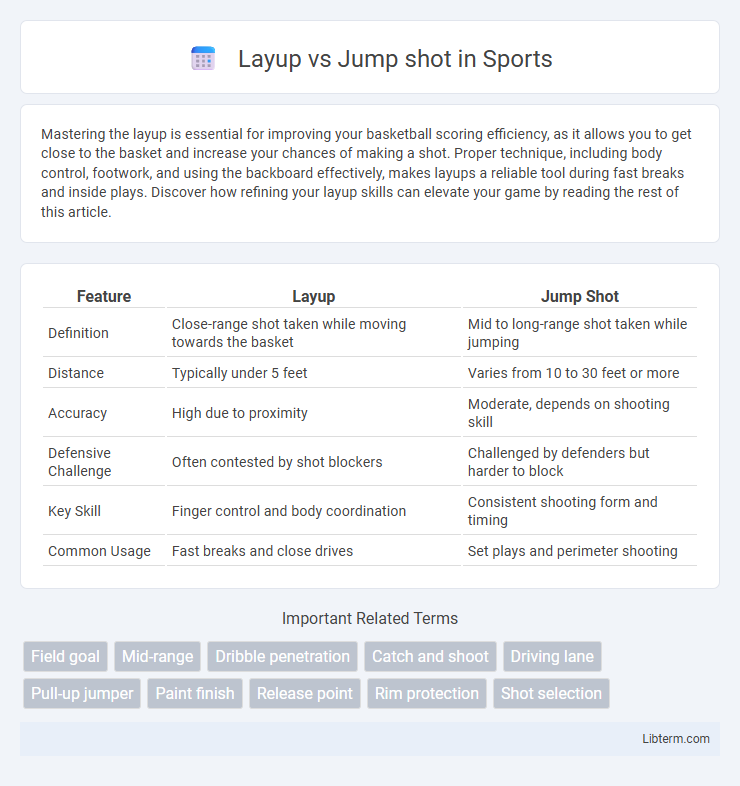Mastering the layup is essential for improving your basketball scoring efficiency, as it allows you to get close to the basket and increase your chances of making a shot. Proper technique, including body control, footwork, and using the backboard effectively, makes layups a reliable tool during fast breaks and inside plays. Discover how refining your layup skills can elevate your game by reading the rest of this article.
Table of Comparison
| Feature | Layup | Jump Shot |
|---|---|---|
| Definition | Close-range shot taken while moving towards the basket | Mid to long-range shot taken while jumping |
| Distance | Typically under 5 feet | Varies from 10 to 30 feet or more |
| Accuracy | High due to proximity | Moderate, depends on shooting skill |
| Defensive Challenge | Often contested by shot blockers | Challenged by defenders but harder to block |
| Key Skill | Finger control and body coordination | Consistent shooting form and timing |
| Common Usage | Fast breaks and close drives | Set plays and perimeter shooting |
Understanding the Basics: Layup vs Jump Shot
A layup involves close-range shooting while driving to the basket, utilizing a smooth, one-handed shot off the backboard for higher accuracy. A jump shot requires elevating off the ground, releasing the ball at the peak of the jump to create distance from defenders, ideal for mid to long-range scoring. Mastery of both shot types is essential for versatile offensive skills in basketball.
Technique Breakdown: How Layups and Jump Shots Differ
Layups involve close-range shots taken while moving toward the basket, emphasizing body control, footwork, and using the backboard for accuracy. Jump shots require vertical elevation, precise hand positioning, and consistent release mechanics to create space from defenders and generate accuracy from mid-to-long range. The key difference lies in the layup's emphasis on agility and timing near the rim versus the jump shot's focus on elevation, shooting form, and follow-through at a distance.
Ball Control: Key Skills for Layups and Jump Shots
Ball control is crucial in executing both layups and jump shots with precision and efficiency. For layups, maintaining a firm grip and close ball proximity to the body ensures seamless navigation around defenders and accurate placement against the backboard. In jump shots, refined ball control aids in a smooth release and consistent trajectory, maximizing scoring potential from mid to long range.
Situational Use: When to Choose a Layup or Jump Shot
A layup is ideal in close-range, fast-break situations where speed and control maximize scoring chances near the basket. Jump shots become essential when defenders block direct paths, requiring elevation and distance to score over opponents. Choosing between a layup or jump shot depends on defender positioning, shot clock urgency, and distance from the rim.
Scoring Efficiency: Success Rates Compared
Layups generally yield higher scoring efficiency than jump shots due to their proximity to the basket and lower defensive contest rate. Studies show layups have success rates around 60-70%, while jump shots typically average 35-45%, varying by distance and defender pressure. Effective offensive strategies leverage layups for high-percentage scoring, reserving jump shots for spacing and catch-and-shoot opportunities.
Defensive Challenges: Contending with Opponents
Contending with opponents during a layup requires managing close-range defensive pressure from shot blockers and rim protectors, demanding quick footwork and body control to avoid blocks and fouls. Jump shots face defenders at a distance, necessitating precise shooting mechanics and the ability to create space through dribbling or screens to counter aggressive closeouts. Understanding positional awareness and timing is crucial in both scenarios to exploit defensive lapses and increase scoring efficiency.
Footwork and Body Movement Analysis
Layup footwork involves a quick, fluid approach with a strong takeoff from the inside foot, enabling close-range precision and balance. Jump shot footwork emphasizes a consistent, square stance with a rhythmic dip and explosive vertical leap, optimizing shooting accuracy and power. Body movement in a layup integrates lean and extension to evade defenders, while a jump shot relies on controlled upper body elevation and wrist snap for trajectory control.
Common Mistakes: Layup vs Jump Shot
Common mistakes in layups often include improper foot placement, leading to loss of balance and reduced accuracy, while jump shots frequently suffer from poor hand positioning and inconsistent release timing. Many players fail to maintain eye focus on the basket during both layups and jump shots, resulting in missed attempts. Mastery of proper mechanics, such as using the correct shooting hand and maintaining body control, is crucial for improving success rates in each shot type.
Training Tips for Mastering Both Techniques
Mastering layups and jump shots requires targeted training that emphasizes footwork, body control, and shooting mechanics. For layups, practicing different angles, developing ambidextrous finishing skills, and incorporating dribbling drills improve versatility and confidence near the basket. Jump shot training benefits from consistent repetition of proper shooting form, balance, and release timing, alongside strength and conditioning exercises to enhance vertical leap and accuracy.
Layup or Jump Shot: Which Improves Overall Game?
Mastering the layup enhances overall basketball performance by improving close-range scoring efficiency and developing body control under pressure. Jump shots expand offensive versatility by encouraging rhythm, balance, and mid-range to long-range scoring capabilities. Integrating both techniques optimizes scoring options and court awareness, significantly elevating a player's game.
Layup Infographic

 libterm.com
libterm.com